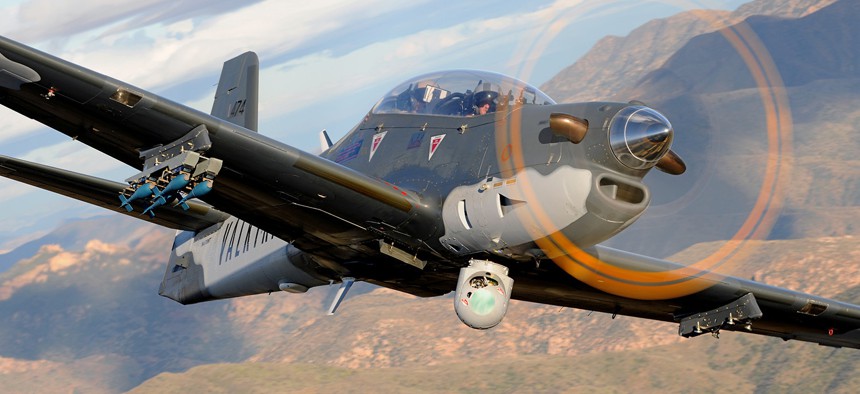
An MX-15D sensor ball by L3 Wescam, mounted on an Embraer Super Tucano. L3 Technologies
How L3 Technologies Is Culture-Shifting Its Way into the Industry’s Top Tier
Over the past 18 months, the company has overhauled its structure and various modus operandi.
For two decades, L3 Technologies operated largely in the shadows — not only publicly, but also within its own walls.
Throughout most of the company’s two-decade existence, executives in a midtown Manhattan highrise quietly oversaw a diverse group of businesses, some of which competed against each other for work. That’s not the case anymore.
Over the past year and a half, the company has undergone a dramatic overhaul in corporate structure and, perhaps more importantly, its culture. Those changes appear to be paying off as the company is winning new business, something executives attribute largely to Chris Kubasik, who became CEO in January 2018.
“This is a very different company than the company I worked with for 20 years,” said Sean Stackley, who oversaw U.S. Navy acquisitions across three presidential administrations.
Stackley now runs L3’s Communications & Networked Systems segment, a group that is looking to become a key supplier of unmanned underwater vehicles.
Kubasik — an accountant by trade who joined L3 as COO in late 2015 — smashed the walls between internal divisions and has reorganized the firm like a more traditional defense company. And as similar operations were combined internally, the company aggressively purchased other firms with unique specialties, particularly unmanned underwater vehicle technology.
The most dramatic move was announced in mid-October, just 10 months into Kubasik’s tenure: a proposed merger between L3 and Harris. Currently under regulatory review, the merger would create America’s sixth-largest defense contractor, behind only Lockheed Martin, Boeing, Northrop Grumman, Raytheon, and General Dynamics.
“Everything is tracking,” Kubasik said of the merger. “We feel confident in a mid-year close.”
L3 and Harris are waiting on regulatory approvals from the U.S. Justice Department, the European Union, and Turkey, Kubasik said.
If that goes through, L3 plans to close its Manhattan corporate headquarters near Grand Central Terminal. Kubasik will move to Harris’ headquarters in Melbourne, Florida, where he is expected to be named COO of the new L3 Harris Technologies.
Cultural Shift
Perhaps one of the bigger signs of the company’s transformation is its successful pursuit of a $500 million contract to upgrade the cockpits of 176 Air National Guard and Air Force Reserve C-130 airlifters. It’s not a huge contract by Pentagon standards, but it will bring a decade of work for the U.S. Air Force.
Company executives say the Air Force contract validates the company’s cultural shift toward operating more like a nimble tech company and less like an old-line defense firm with layers upon layers of bureaucracy.
Two years ago, the company began using innovation sprints — a technique used by Google and other Silicon Valley firms — to come up with a solution to a problem in a week’s time.
“We’ve modified that for how we work with the defense industry,” said Jeff Miller, who leads L3’s Intelligence, Surveillance and Reconnaissance Systems segment.
In 2017, they used the process four times. In 2018, they did 65 sprints and are on pace to do even more this year.
“When you do something like this in a week, there is every chance you are going to fail during that week and you might learn something,” Miller said. “I think the biggest impact that we’ve seen out of this is when our engineers or other people leave these sprints, they leave thinking about their daily job and how they could do it differently and start to believe that failing fast is okay in our culture. It’s a huge cultural impact on what we’ve done with the organization.”
The company used sprints as it sought to trim costs from its C-130 bid.
“I don’t think we had a winning proposal before we brought this mindset to it,” Miller said.
The new company culture does not punish employees who are unsuccessful during these sprints.
“I think we get more value out of the failures in sprints than the successes,” Miller said.
Now, with the U.S. C-130 contract in hand, executives say, L3 has the lead in the race to win work worth upwards of $1.5 billion from allies who fly older C-130s.
“This is a big win for L3 Technologies,” Kubasik said. “It also opens up the opportunity for significant international opportunities as well.”
Now the company is aggressively pursuing a major helicopter deal with the Army, called the Future Attack Reconnaissance Aircraft. L3, who has partnered with AVX Aircraft to design and build a new military helicopter from scratch. A black model sat on in the center of the boardroom table during L3’s briefing on Thursday.
“It does bring us into what traditional people would call the OEM realm, but we really look at it as, we are providing a solution to a problem out there,” said Luke Savoie, president of L3’s Surveillance and Strike Systems sector.




